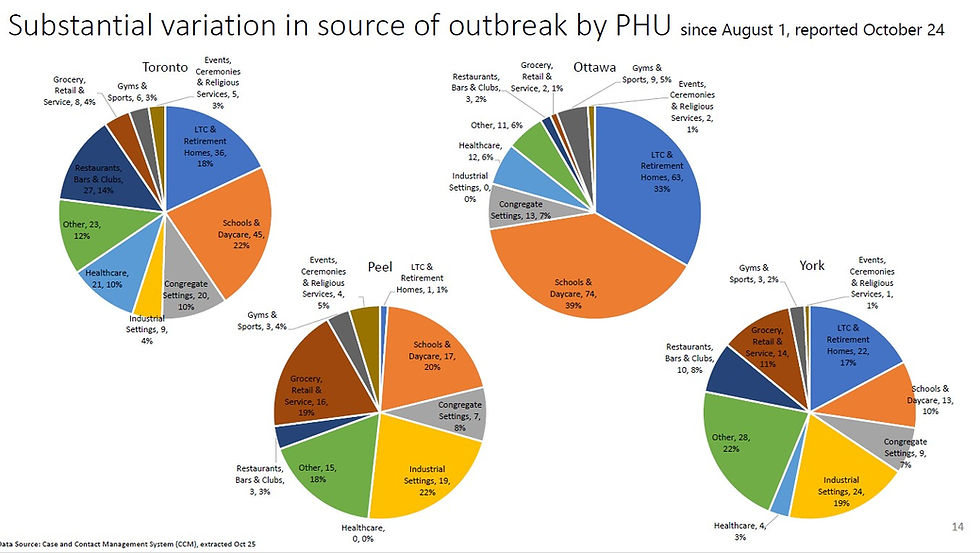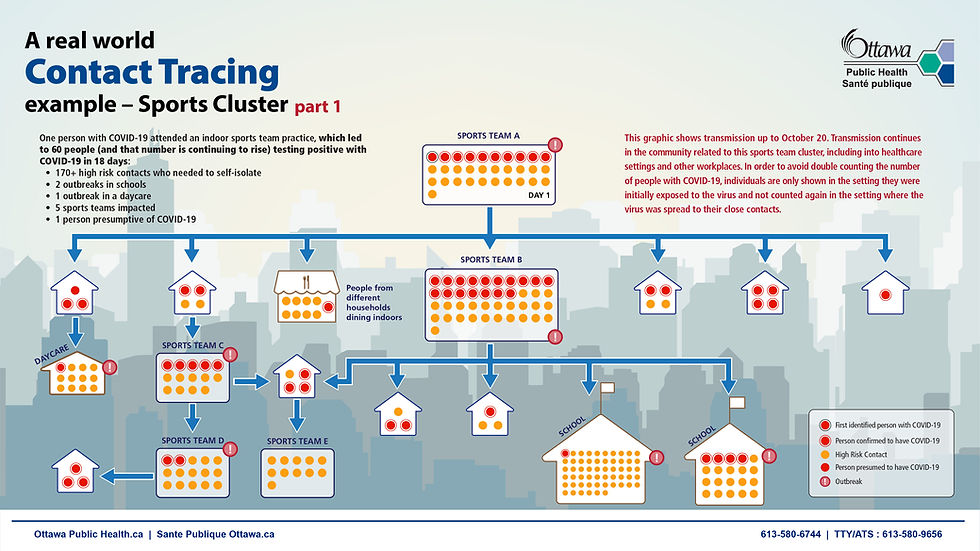Pandemic Recovery with Sports
- David Thibodeau

- Dec 15, 2020
- 7 min read
I wanted to take the last article of 2020 to reflect on some of the challenges that grassroot sports have faced this year and consider some of the challenges and opportunities that will come in the future.
Sport and recreation during a pandemic
As a swim coach for a community sport team I see firsthand some of the impacts that sports are feeling from COVID-19 restrictions.
There is less facility time available for people to rent. The group that I coach now is practicing 3 hours less a week in total compared to last year. Other groups are in the pool even less. I’m curious to see if this has long term impacts on athlete development? Will high performance athletes in ten years not be at the same level as athletes today due to this time?
There has also been unfortunately a loss of coaches, not all coaches were able to coach this year due to various reasons. I think that this is a challenge because it means that we lose a lot of valuable talent in coaching.
Teams and clubs were not able to welcome back as many athletes due to restrictions placed on how many people can be inside, can be in groups or can be in lanes in a pool. This means that not as many young people are able to participate in sport, we have already been seeing a decline in people participating in organised sport over the last few years, COVID-19 has accelerated this trend even more.
These effects have negative impacts on sport development and athlete development. There are other effects that stem from this as well, such as financial challenges. With not being able to welcome back as many athletes, revenues go down, while in some cases expenses may go up. There can be more costs to running a sport program now, buying the proper safety equipment (masks, sanitizer, etc). When there are less athletes it also means that the cost per athlete to rent space goes up. It is more expensive to run sport programs during COVID-19.
One challenge that I experience as a coach that may not have an impact on sports as a whole is not being able to connect with the athletes as much. I always try to prioritize getting to know the kids as much as possible during the year, but this year with social distancing, face masks and no no informal chat time before or after practice (we show up, get in the pool, and then leave), there is very little opportunity for me to get to know the athletes better. I wonder if this will have an impact on retention rates in athletes. Will athletes drop out of sports because their relationship with their coach (and other athletes) has changed and it isn’t as fun with all the restrictions and safety measures?
In the future when we are building back a challenge that we will be faced with is trying to get those athletes that we lost due to capacity, back into sport.
While the arrival of the vaccine is good news, many questions still remain on how widespread uptake will be around the world. Will it be safe to host large sporting events in the coming years? Will the Olympic Games be able to go ahead as planned in summer 2021? The IOC has suggested that they will cover the costs of the vaccine for athletes, should they choose to get one (they will not make it mandatory). This raises questions about mission staff that will accompany the teams to Tokyo. It also raises the question if the vaccine will be readily available to athletes by then. Of course individual National Olympic Committees can enforce their own policies that will not allow athletes or staff to go unless they have been vaccinated, especially if not everyone in attendance will be vaccinated. Sending anyone into a global event with thousands of people is a very big risk.
I think that currently though, most athletes training for the Olympics, already had to stop training for a few months during the first lock down. Since then with the reopening of society, training time has been reduced. During the second wave and new restrictions, some athletes are exempt from the lockdowns. For example, in Toronto, Canada, sport and recreation facilities are closed. Section 48, Facilities for indoor or outdoor sports and recreational fitness activities, in Reopening Ontario (A Flexible Response to COVID-19) Act, 2020 states:
A facility for indoor or outdoor sports and recreational fitness activities may open if it meets the following conditions:
1. The facility is,
i. operated by, or for the sole use of, persons who are athletes, coaches or officials training or competing to be a part of Team Canada at the next summer or winter Olympic Games or Paralympic Games, if the persons are,
identified by a national sport organization that is either funded by Sport Canada or recognized by the Canadian Olympic Committee or the Canadian Paralympic Committee [...]
3. The only persons permitted to enter and use the facility must be,
i. players, athletes, coaches or officials who are using the facility for the purposes of training or conditioning, and
ii. such staff as are strictly necessary to operate the facility and support the training or conditioning of the players.
Similar practices are being done in France despite another lockdown as well, where high level athletes are allowed to train.
I’m interested to know that if in these cases athletes are able to get back to their regular training schedules? Because no one else is using the facilities now, are they able to practice more? How prepared will they be if the Olympic Games are hosted next summer?
For a lot of the time it seems that community sport is always put on the low priority list. When lock downs started coming back in, the first thing to go were gyms and fitness centres. In the Canadian province of Ontario, in the diagram below, you can see a breakdown of where COVID-19 outbreaks are occurring in the four hardest hit regions in Ontario. (Note: an “outbreak” is not defined so it is not clear how many cases are associated with a single outbreak). But as you can see from the below charts that a total of 21 outbreaks has occurred in gym & sport settings in four regions.
The below graphic details a real world example of a sport outbreak in Ottawa, Canada. 60 people tested positive after someone attended a team practice. This really stresses the importance of staying home when you are feeling ill. And it does also highlight that nothing is without risk. Even allowing high level athletes and professional sports to continue during a lockdown, there are risks.
Looking Forward
Sport and recreation will be struggling to build back, as all sectors of society will be. Governments need to prioritize and realize the potential that sport has to help build back.
I think that it will be some time before we will be able to host large scale international events like we used to with thousands of spectators coming from around the world. These events will continue to pose health risks as vaccines will not be readily available everywhere that quickly, and the effectiveness of a vaccine also depends on mass uptake. There will also be many people who will not want to be in large crowds yet. Since we have been social distancing for so long, some people will still feel uncomfortable in large crowds for a while yet.
However, I believe that there is a lot of value in sporting events. Several professional sporting leagues like the NHL and NBA, created bubbles to hold a modified season. These bubbles had varying degrees of success. It is certainly not impossible to host large sport events and keep everyone safe. As always, the Olympics will be seen and used as a symbol of unity, strength and excellence, which is important to show during a global pandemic. However, it must be done to ensure the safety of all volunteers, staff and athletes.
Sport and recreation will be struggling to build back, as all sectors of society will be. Governments need to prioritize and realize the potential that sport has to help build back. There is a lot of momentum behind sports and recreation, and now is the time for governments to invest in those types of infrastructure while there is widespread support.
On December 1st 2020, the United Nations General Assembly adopted a draft resolution titled “Sport as an enabler of sustainable development”. This year’s test incorporates new additions that recognize the important role that sport and physical activity will have in post-pandemic recovery plans. The Secretary-General also published the report titled “Sport: a global accelerator of peace and sustainable development for all”.
Now is the time for people to reclaim cities that for so long have been designed for cars. Recovery from COVID-19 means making our communities stronger, healthier and more resilient. Part of this plan will include increasing segregated bike lanes throughout cities. Making biking safe for citizens makes it accessible. In many places a lot of spending will have to occur to build proper active transport infrastructure.
Putting aside more public green spaces is also needed. This needs to be done in cities and around cities. More parks in cities will help make green space accessible to people who do not have cars. More parks outside of cities will help preserve our ecosystems and also increase the capacity of our parks. Gatineau Park in Canada’s National Region, had several days where they were at full capacity. Increasing park areas can make sure that no one is turned away and that everyone can always enjoy nature.
Governments must also place a focus on the importance of sport organisations and their contributions to society. Sports can be used to fight specific local issues. Highlighted in the UN Secretary-General's report is the role of sport as a catalyst of social and economic development, health and societal change. It highlights the needs of sport organisations like the International Cycling Union to take a greater leadership role in promoting active transport in cities.
Governments must change policies to include sport. Economic recovery packages must invest in sport programming, for all ages, we must make the appropriate investments to make sport and recreation accessible. For many years in my hometown of Fredericton, New Brunswick, Canada there has been an ongoing drama for if there will be a new pool built. These questions must not be asked anymore. No community should go without basic infrastructure.
Sport and recreation must be included in anti-poverty plans, they must be included in plans to help rebuild community connections, in education, in city planning, in climate action plans. There are many ways that sport can be used in new ways to build back better.
More than ever governments will have to prioritize physical activity and getting people back into sport. Creating active zones, shutting down streets for play, revamping physical education classes, making youth clubs financially accessible. Now is the time for bold ideas.
Moving forward, sport organisations must look at the bigger picture of how their sport can help shape society. Governments must also look at sport innovatively and examine how sport can be used to meet their policy objectives. Sport is no longer just about entertainment, it’s about values.






コメント